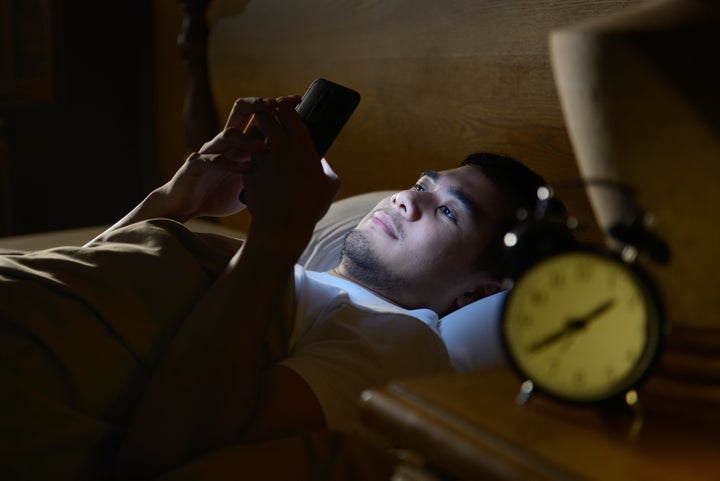[ad_1]
If you feel like you’ve been swept into a torrent of never-ending bad news about the coronavirus, you’re not alone. Around the world, people are realizing they’re teetering on a fine line between staying informed and slipping into media overload.
Each day brings an influx of new information about COVID-19 — more cases, a new death toll, temporary morgues and new symptoms. There are tragic stories from exhausted health care workers and families who had to say goodbye to loved ones through a window. It can be hard to look away.
Now, people are starting to feel the effects of being inundated by COVID-related news. For many, the stream of information has brought on bouts of fear and anxiety. Some develop physical symptoms, like lightheadedness, chest tightness and insomnia, while others are feeling really bummed out.
This comes as no surprise to mental health experts. The media plays a huge role in our overall well-being, and we know from past disasters that what we read and watch online and on TV can have a profound, lasting impact on our mental and physical health.
Here’s what happens to the body and brain when we consume too much coronavirus news:
Stressful news activates our fight-or-flight response

You may notice that after reading one too many articles about coronavirus your body starts to feel a bit off. Perhaps your heart races or your breath quickens. Maybe you feel restless or jittery, experience trouble falling asleep at night, or have vivid nightmares.
This is because when we’re exposed to a stressor ― even indirectly as we are through the media ― our fight-or-flight response turns on, which is our body’s way of dealing with a perceived threat.
Past evidence demonstrates that “when the brain is shown images of something potentially traumatic, the centers of the brain that are responsible for fear response light up [and] the centers of brain that are related to the development of PTSD light up,” said Alison Holman, a psychologist and associate professor of nursing at the University of California Irvine.
When people constantly expose themselves to anxiety-inducing news, they’re making their brain perceive a threatening, stressful event over and over. Needless to say, this can take a major toll on health over time.
“If you’re repeatedly exposed to that stressor, it can lead to a depressed mood, it can lead to insomnia, fatigue [and] a decline in concentration,” said Collin Reiff, a psychiatrist at NYU Langone Health.
Holman, who has studied the media’s role in past disasters and epidemics, said that the more people engage with high-stress media, the more likely they are to report higher levels of acute stress and anxiety.
This phenomenon has been well documented over time. With the 2014 Ebola crisis, for example, people who consumed more media about the outbreak experienced higher levels of distress and worry than those who viewed less Ebola-related news.
The same goes with other disasters. A report looking at 9/11 found that people who viewed several hours of TV a day had a higher risk of post-traumatic stress symptoms and new physical health problems, predominantly with the heart, in the years that followed. Research on the Boston Marathon bombings showed that acute stress symptoms were highest among people who consumed the most news, even compared with people who actually witnessed the bombings.
According to Holman, what people see matters just as much as how much news they watch. Her research on the Boston Marathon bombings discovered that the more gruesome and graphic the coverage, the more distress and impaired functioning people experienced.
We can get trapped in a vicious cycle of news consumption, leading to mental and physical health issues like insomnia
During times of uncertainty and instability, people turn to the news for reassurance and guidance, according to a report published in March by the American Psychological Association. But when information is ineffectively communicated — due to the sensationalization of what’s going on or misinformation— people’s anxiety and perceptions of risk can quickly increase.
This can trap people in a vicious cycle, said Yuval Neria, a professor of medical psychology at Columbia University and the director of trauma and post traumatic stress disorder at the New York State Psychiatric Institute.
“During the ongoing exposure to this rapidly spread, deadly outbreak, we often feel anxious and then turn to social and digital media,” Neria said. “High exposure to the media may in turn make us even more anxious and distressed, which in turn will intensify social media consumption.” It can quickly start to feel like doomsday.
Over time, excess exposure to stressful media can lead to chronic anxiety, depression and insomnia. It can also trigger a variety of physical health problems, like heart disease, diabetes, early aging and suicidal risk, according to Neria.
The pandemic is chronically unfolding, which exacerbates issues

Holman, who is researching how coronavirus news is impacting people’s health, said what’s particularly concerning is how incessant and multifaceted the news is.
The coronavirus isn’t a standalone event. It’s an unfolding crisis that’s triggering secondary stressors — the growing number of new cases and deaths, the spike in unemployment, a volatile stock market, and political turmoil.
“What’s happening, I think, is people are being exposed to new information, much of which is anxiety-provoking, over and over and over again,” Holman said.
When you combine that constant exposure and a 24/7 output of new information that’s not at all positive, it can really wear on people, Holman added.
How much news should you read?
Though each person’s threshold varies, Holman recommended choosing one or two news sources that are reliable and reputable. Look for a source that will give you the facts and not try to scare you.
Then, set some boundaries. Holman suggested checking in a couple times a day, at most.
“Get the information you need and don’t keep going back to it,” Holman said. Considering how gruesome content can have a greater impact on mental health, try to skip upsetting images.
Finally, Reiff said it’s important to focus on the facts and keep in mind that the news typically covers negative events ― like the number of deaths and new cases ― and not the positive outcomes, such as how many people are recovering and being released from hospitals (which is actually quite a lot!).
If people are following health recommendations — practicing good hygiene, staying at home and social distancing — then they’re doing their part to help protect themselves and others from COVID-19. Even if they do contract the virus, Reiff added, there’s a very small chance it’ll wind up being lethal. Just keep these points in perspective when you start to go down a bad thought spiral.
A HuffPost Guide To Coronavirus

















